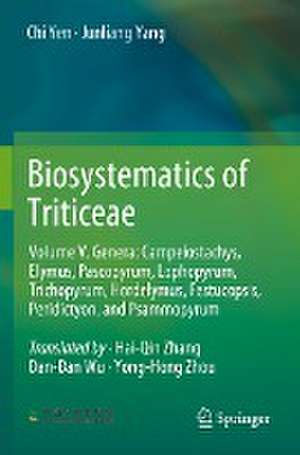Biosystematics of Triticeae: Volume V. Genera: Campeiostachys, Elymus,Pascopyrum, Lophopyrum, Trichopyrum, Hordelymus, Festucopsis, Peridictyon, and Psammopyrum
Autor Chi Yen, Junliang Yang Traducere de Hai-Qin Zhang, Dan-Dan Wu, Yong-Hong Zhouen Limba Engleză Paperback – 15 aug 2023
This book covers taxonomy, cytogenetics, and molecular phylogeny. It summarizes the biosystematics of Triticeae with comprehensive and updated data. This book is divided into five volumes (Volumes 1- 5), and includes 30 genera, 2 subgenera, 464 species, 9 subspecies, and 186 varieties in Triticeae. Volume 5 introduces nine perennial genera in Triticeae: Campeiostachys, Elymus, Pascopyrum, Lophopyrum, Trichopyrum, Hordelymus, Festucopsis, Peridictyon, and Psammopyrum.
Elymus (StH), Campeiostachys (StYH), Lophopyrum (E), and Trichopyrum (ESt)are polymorphic genus. They show similar morphological characters, and it is difficult to distinguish them based merely on morphological variation. Pascopyrum (StHNsXm), Hordelymus (XoXr), Festucopsis (L), Peridictyon (Xp), and Psammopyrum (EL) are small genera, mostly monotypic genera.
This book can serve as highly qualified, valuable, and convenient handbooks for audiences who are interested in Triticeae. This book also includes many illustrations, in addition to the description, to help the audience understand, morphological features of the concerned taxa, which makes the explanation more precise andobvious. It is a useful tool to understand the relationship among species in Triticeae.
Toate formatele și edițiile
| Toate formatele și edițiile | Preț | Express |
|---|---|---|
| Paperback (2) | 650.51 lei 6-8 săpt. | |
| Springer Nature Singapore – 15 aug 2023 | 650.51 lei 6-8 săpt. | |
| Springer Nature Singapore – 26 aug 2021 | 1195.93 lei 6-8 săpt. | |
| Hardback (2) | 657.42 lei 6-8 săpt. | |
| Springer Nature Singapore – 14 aug 2022 | 657.42 lei 6-8 săpt. | |
| Springer Nature Singapore – 10 mar 2020 | 1201.85 lei 6-8 săpt. |
Preț: 650.51 lei
Preț vechi: 765.30 lei
-15% Nou
Puncte Express: 976
Preț estimativ în valută:
124.53€ • 128.07$ • 103.31£
124.53€ • 128.07$ • 103.31£
Carte tipărită la comandă
Livrare economică 19 februarie-05 martie
Preluare comenzi: 021 569.72.76
Specificații
ISBN-13: 9789811900174
ISBN-10: 9811900175
Ilustrații: XVII, 712 p. 1 illus.
Dimensiuni: 155 x 235 mm
Greutate: 1.01 kg
Ediția:1st ed. 2022
Editura: Springer Nature Singapore
Colecția Springer
Locul publicării:Singapore, Singapore
ISBN-10: 9811900175
Ilustrații: XVII, 712 p. 1 illus.
Dimensiuni: 155 x 235 mm
Greutate: 1.01 kg
Ediția:1st ed. 2022
Editura: Springer Nature Singapore
Colecția Springer
Locul publicării:Singapore, Singapore
Cuprins
Chapter 1. Biosystematics of Genus Campeiostachys.- Chapter 2. Biosystematics of Genus Elymus.- Chapter 3. Biosystematics of Genus Pascopyrum.- Chapter 4. Biosystematics of Genus Lophopyrum.- Chapter 5. Biosystems of Genus Trichopyrum.- Chapter 6. Biosystematics of genus Hordelymus.- Chapter 7. Biosystematics of Genus Festucopsis.- Chapter 8. Biosystematics of Genus Peridictyon.- Chapter 9. Biosystematics of Genus Psammopyrum.-
Notă biografică
Hai-Qin Zhang, Yong-Hong Zhou, and Dan-Dan Wu focus on studies of biosystematics of Triticeae, especially for the perennial Triticeae species. They have carried out extensive research into the perennial Triticeae species, including clarifying the genomic constitutions of species, the phylogeny of Triticeae species, and their breeding utilization.
Textul de pe ultima copertă
This book review and rearrange the research data of Triticeae published over hundreds of years, applying a modern scientific approach. Triticeae is an important tribe in the grass family (Peaceae). It includes the major cereal crops, such as wheat, barley and rye, in addition to many valuable forage crops found in different genera, such as Elymus, Agropyron, Pasthyrostachys, and Leymus. The knowledge of appropriate Triticeae taxonomy and biosystematics will serve as genetic breeding of wheat, barley, rye and forage grass. The authors attempted to remain the truth and remove the false for deriving a more natural biosystematics of Triticeae.
This book covers taxonomy, cytogenetics, and molecular phylogeny. It summarizes the biosystematics of Triticeae with comprehensive and updated data. This book is divided into five volumes (Volumes 1- 5), and includes 30 genera, 2 subgenera, 464 species, 9 subspecies, and 186 varieties in Triticeae. Volume 5 introduces nine perennial genera in Triticeae: Campeiostachys, Elymus, Pascopyrum, Lophopyrum, Trichopyrum, Hordelymus, Festucopsis, Peridictyon, and Psammopyrum.
Elymus (StH), Campeiostachys (StYH), Lophopyrum (E), and Trichopyrum (ESt)are polymorphic genus. They show similar morphological characters, and it is difficult to distinguish them based merely on morphological variation. Pascopyrum (StHNsXm), Hordelymus (XoXr), Festucopsis (L), Peridictyon (Xp), and Psammopyrum (EL) are small genera, mostly monotypic genera.
This book can serve as highly qualified, valuable, and convenient handbooks for audiences who are interested in Triticeae. This book also includes many illustrations, in addition to the description, to help the audience understand, morphological features of the concerned taxa, which makes the explanation more precise andobvious. It is a useful tool to understand the relationship among species in Triticeae.
This book covers taxonomy, cytogenetics, and molecular phylogeny. It summarizes the biosystematics of Triticeae with comprehensive and updated data. This book is divided into five volumes (Volumes 1- 5), and includes 30 genera, 2 subgenera, 464 species, 9 subspecies, and 186 varieties in Triticeae. Volume 5 introduces nine perennial genera in Triticeae: Campeiostachys, Elymus, Pascopyrum, Lophopyrum, Trichopyrum, Hordelymus, Festucopsis, Peridictyon, and Psammopyrum.
Elymus (StH), Campeiostachys (StYH), Lophopyrum (E), and Trichopyrum (ESt)are polymorphic genus. They show similar morphological characters, and it is difficult to distinguish them based merely on morphological variation. Pascopyrum (StHNsXm), Hordelymus (XoXr), Festucopsis (L), Peridictyon (Xp), and Psammopyrum (EL) are small genera, mostly monotypic genera.
This book can serve as highly qualified, valuable, and convenient handbooks for audiences who are interested in Triticeae. This book also includes many illustrations, in addition to the description, to help the audience understand, morphological features of the concerned taxa, which makes the explanation more precise andobvious. It is a useful tool to understand the relationship among species in Triticeae.
Caracteristici
Summarizes the biosystematics of Triticeae with comprehensive and updated data A useful tool to understand the relationship among species in Triticeae Includes 30 genera, 2 subgenera, 464 species, 9 subspecies, and 186 varieties in Triticeae
